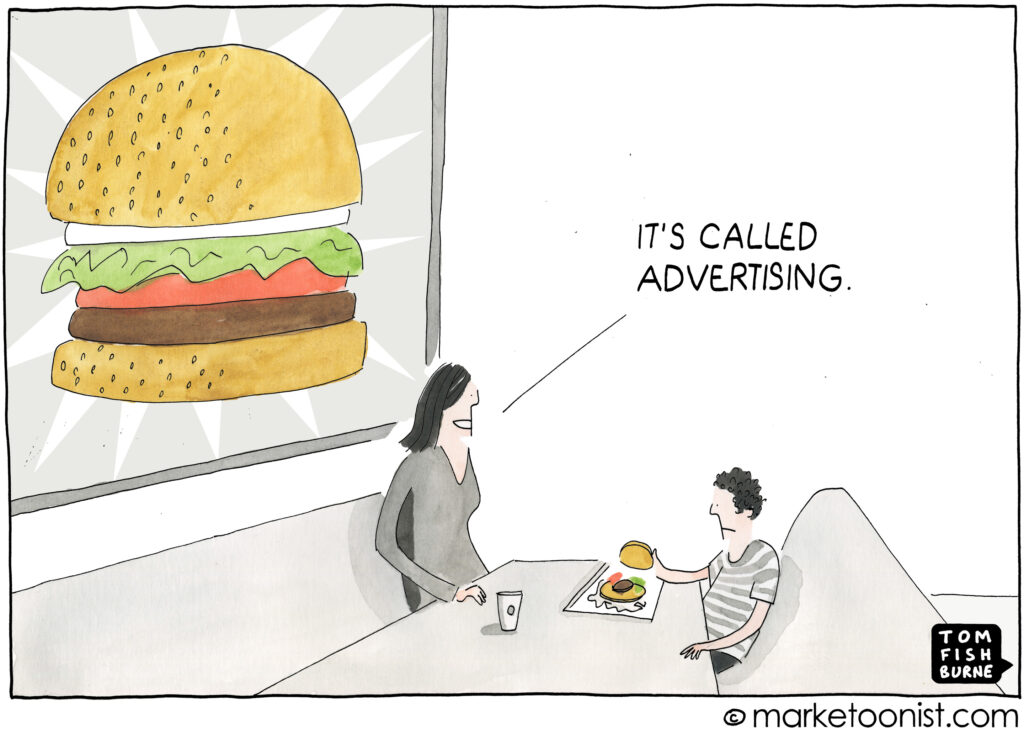A recent “marketing versus advertising” Google search produced 357 million search results.
It became great reading as pundits from all corners of the great earth testifying eloquent definitions, distinctions, and differences and why it’s vital to know the difference.
I even found a Google article (page one ranked!) entitled, “Marketing vs Advertising: Which Will Make You More Money?” Wow.
Here’s a thought…who cares?
Life is complicated enough, wouldn’t you agree?
Let’s keep it simple.
Advertising is what you say.
Marketing is how you say it.
But here’s a golden rule from a man who needs no introduction…
“What you say in advertising is more important than how you say it.”
David Ogilvy, Confessions of an Advertising Man
As the demand for consumer attention continues to reach new highs, what brands say have never been more important.
But the marketing world will tell you differently—relentlessly pursuing shiny objects, finding new and buzzworthy mediums, and scaling content distribution.
Marketing buzzards think it’s all about content for content’s sake, at scale – who cares about what you actually say?
And yet they wonder why nobody pays attention and they get no results…
I used to believe the old marketing cliché… “content is king.”
But the truth is, effective copywriting has always been king.
And that’s where I’m spending my next 10,000 hours for my marketing apprenticeship, learning from the truly great “Mad Men” of advertising who didn’t have the luxury of today’s hyperactive, instantaneous digital marketer.
Bad Advertising
It’s easy to fall into the “people hate advertising” trap, but what people really hate is BAD advertising.
Unfortunately, we have two challenges ahead—a surplus of advertising seeking attention 24/7, which means more BAD advertising.
Bad advertising is everywhere, and that’s really why nobody is paying attention.
Why should they?
The message is off point, irrelevant, and offers no value. The consumer has not given you permission to serve them the ad (see Seth Godin,)—your ad is interruptive, intrusive, and outright SPAM.
And the absolute best way to destroy your brand is to track and retarget consumers with your bad advertising – soundly reinforcing and growing negativity around your brand – creating a small army of vocal and disgruntled advocates ready to spread the good word about your business.
It goes back to what I’ve been preaching all along…patience.
Patience to develop a well-thought campaign that educates and aligns consumers at the appropriate stage of their journey. Remove the risk, give more value upfront, and earn trust. But this requires patience…a timeline you don’t control, and a longer-term strategic approach.
Do you have what it takes?
Sure, immediate short-term wins are available—but it lacks equity. It’s running fast on a “hamster wheel” marketing that’s on lease. A path of MOST resistance.
It’s a perfect strategy for marketing hypesters, spammers, and consumer surveillance freaks.
But the good news, as a brand you have a choice of which path you want to take.
Marketing the McDonalds Way
Today, marketing is like drive-through fast food.
You can launch an ad online or social media in the exact same time (or less) than picking up some cheeseburgers in a McDonald’s drive-through.
And that convenience creates a massive opportunity for BAD advertising.
When it’s too easy, fools rush in.
It’s a short-cut. You don’t need to bother with the thinking/strategy part of it – you just pull your brand up to the advertising drive-through window and order away!
And just think how FAT we’ve made Facebook & Google hitting up their advertising drive-throughs…think they care if what you order is not good for you?
Order up!
It’s the predicament that all marketers and brands have today and it’s dangerous.
And it’s super unhealthy for the business of advertising.
We’ve almost destroyed advertising’s very foundation and made the already difficult journey of building consumer trust infinitely harder.
For clues on where this is all heading consider that in 2019, roughly 26% of internet users were blocking advertising on their connected devices. (www.statista.com)
One out of every four consumers have already “had enough” bad advertising.
And call me crazy, but that’s why I love the challenge of marketing today.
It’s why I’ve invested 10,000 hours into understanding how this all works and still don’t have it remotely figured out. (Well, maybe a wee bit more than I’ll take credit for.)
Marketing imposters are everywhere, you can easily spot them in any crowd – they spew BAD advertising all over the place and don’t take the mission and privilege of earning consumer attention and trust seriously.
The marketing answers are out there for everyone to find, but you got to put in the work, have the patience and set your compass so it’s always aligned to being of service to whomever, you seek to serve.
Enjoy your journey.
